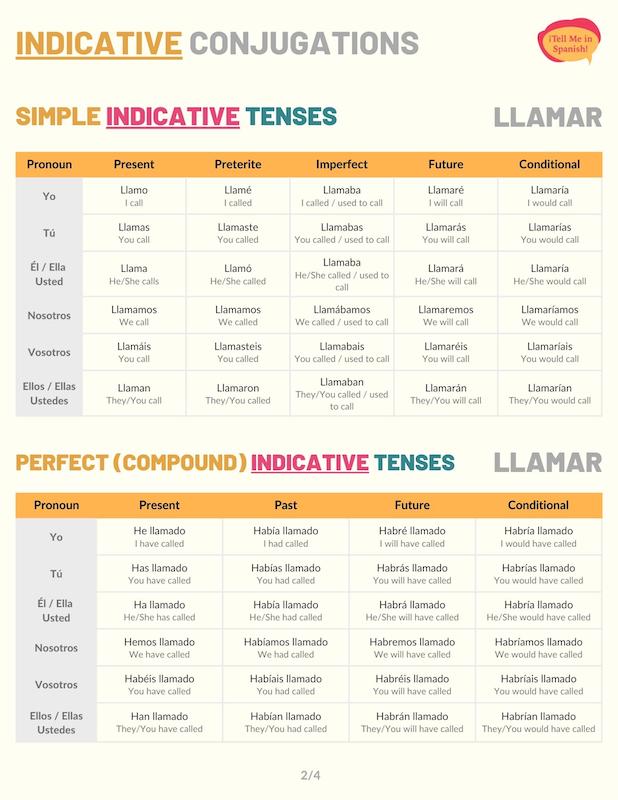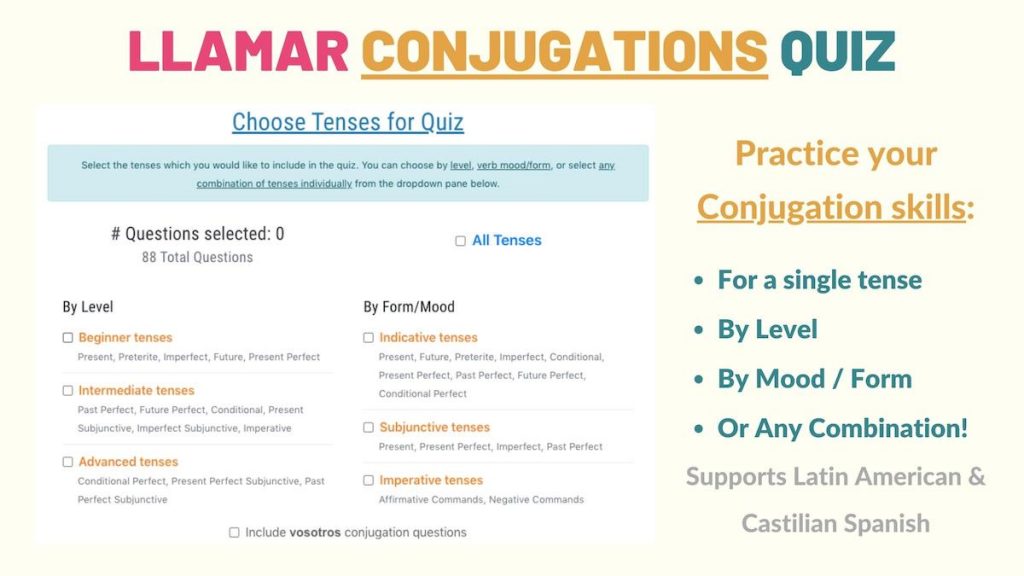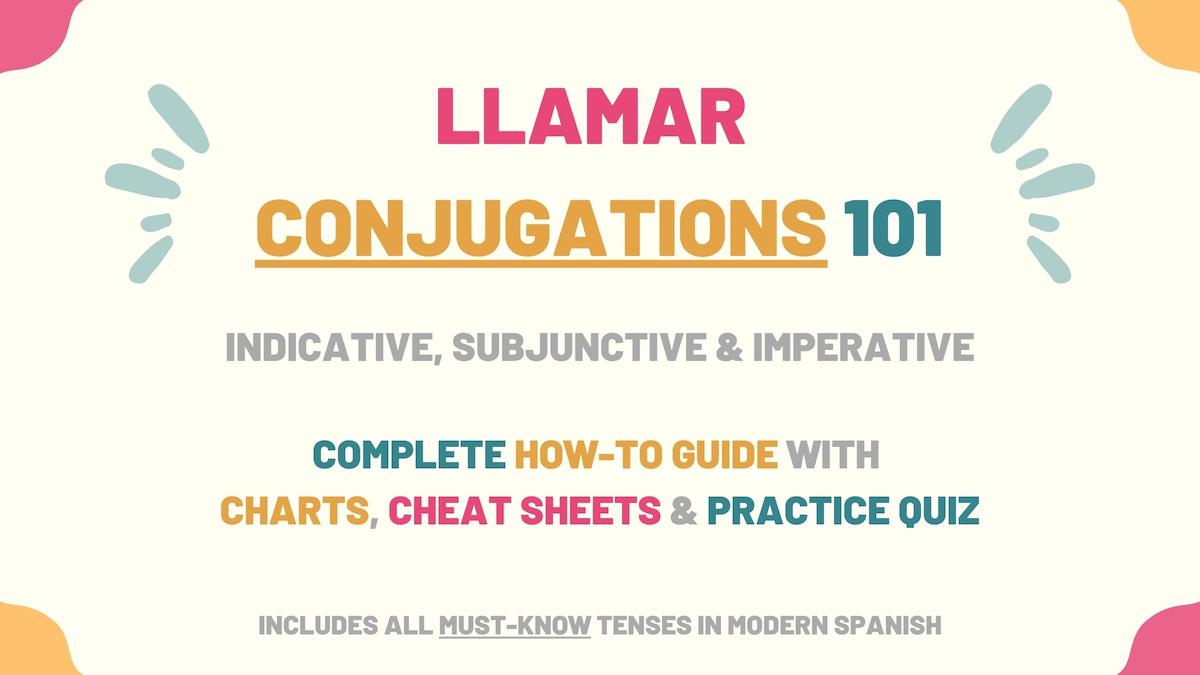Llamar is a regular -AR verb with multiple basic applications. Since it can help you sound more natural while practicing the -AR conjugation pattern, in this guide, we’ll review llamar conjugation patterns.
- Llamar Overview
- Indicative Tenses of Llamar Conjugations
- Subjunctive Tenses of Llamar Conjugations
- Imperative (Commands) of Llamar Conjugations
- Uses & Examples
- Download Llamar Conjugation Tables & Uses Cheat sheets
- Llamar Conjugation Practice Quiz
The Spanish verb llamar has different meanings depending on the parts of speech you use. The conjugation charts below only have one translation to keep the tables as straightforward as possible. You can learn more about the applications of this verb in the section Uses & Meanings.
Overview of Llamar
| Verb Characteristic | Property |
|---|---|
| Verb Type | -AR |
| Irregular | No |
| Infinitive | Llamar |
| Gerund (Present Participle) Form | Llamando |
| Past Participle Form | Llamado |
| Synonyms | Marcar, hablar, gustar. |
Indicative Conjugations of Llamar
Present tense
Llamar conjugations in the present tense communicate that someone calls another person. If combined with a reflexive pronoun, these forms are used to say your name in Spanish. For example: Hola, me llamo Daniela y ella se llama Samantha.
| Person | Conjugation | Translation |
|---|---|---|
| Yo | Llamo | I call |
| Tú | Llamas | You call |
| Él / Ella Usted | Llama | He/She calls You (formal) call |
| Nosotros | Llamamos | We call |
| Vosotros | Llamáis | You call |
| Ellos / Ellas Ustedes | Llaman | They call You (plural) call |
Preterite tense
Llamar preterite conjugation chart displays the regular endings you must use with this verb. When conjugated to the preterite form, you can use this verb to say you called someone. For example: Oye, David te llamó hace un rato.
| Person | Conjugation | Translation |
|---|---|---|
| Yo | Llamé | I called |
| Tú | Llamaste | You called |
| Él / Ella Usted | Llamó | He/She called You (formal) called |
| Nosotros | Llamamos | We called |
| Vosotros | Llamasteis | You called |
| Ellos / Ellas Ustedes | Llamaron | They called You (plural) called |
Take Note: In Mexican Spanish, it’s more common to use the hablar conjugations to express that someone calls another person.
Imperfect tense
Llamar past imperfect conjugations convey that someone used to call another person repeatedly in the past. Also, use this tense when trying to remember what someone’s name is. For example: ¿Cómo se llamaba tu vecina?
| Person | Conjugation | Translation |
|---|---|---|
| Yo | Llamaba | I called I used to call |
| Tú | Llamabas | You called You used to call |
| Él / Ella Usted | Llamaba | He/She called He/She used to call You (formal) called You (formal) used to call |
| Nosotros | Llamábamos | We called We used to call |
| Vosotros | Llamabais | You called You used to call |
| Ellos / Ellas Ustedes | Llamaban | They called They used to call You (plural) called You (plural) used to call |
Near future
The immediate future in Spanish is formed with ir in present tense + a + infinitive verb (llamar in this guide). When using these llamar conjugations, you’re saying that a person will call someone soon in the future. ¿A qué vas a llamar a tu papá?
| Person | Conjugation | Translation |
|---|---|---|
| Yo | Voy a llamar | I’m going to call |
| Tú | Vas a llamar | You’re going to call |
| Él / Ella Usted | Va a llamar | He/She is going to call You (formal) are going to call |
| Nosotros | Vamos a llamar | We’re going to call |
| Vosotros | Vais a llamar | You’re going to call |
| Ellos / Ellas Ustedes | Van a llamar | They’re going to call You (plural) are going to call |
Future simple tense
The future tense forms of llamar allow you to say that someone will call another person in the future. When using reflexive pronouns, you can use these forms to say what someone’s name will be. La llamaremos cuando sus resultados estén listos.
| Person | Conjugation | Translation |
|---|---|---|
| Yo | Llamaré | I will call |
| Tú | Llamarás | You will call |
| Él / Ella Usted | Llamará | He/She will call You (formal) will call |
| Nosotros | Llamaremos | We will call |
| Vosotros | Llamaréis | You (formal) will call |
| Ellos / Ellas Ustedes | Llamarán | They will call You (plural) will call |
Conditional tense
When conjugated to the Spanish conditional tense, these forms communicate that someone would call another person. These forms can also be used to say what a person’s name would be. Si tuviera una niña, la llamaría Frida.
| Person | Conjugation | Translation |
|---|---|---|
| Yo | Llamaría | I would call |
| Tú | Llamarías | You would call |
| Él / Ella Usted | Llamaría | He/She would call You (formal) would call |
| Nosotros | Llamaríamos | We would call |
| Vosotros | Llamaríais | You would call |
| Ellos / Ellas Ustedes | Llamarían | They would call You (plural) would call |
Present perfect tense
The present forms of haber + llamado (past participle) are the elements you must use to form the present perfect in Spanish. Use these conjugations to say that someone has or hasn’t called. For example: Mi hermano no nos ha llamado.
| Person | Conjugation | Translation |
|---|---|---|
| Yo | He llamado | I have called |
| Tú | Has llamado | You have called |
| Él / Ella Usted | Ha llamado | He/She has called You (formal) have called |
| Nosotros | Hemos llamado | We have called |
| Vosotros | Habéis llamado | You have called |
| Ellos / Ellas Ustedes | Han llamado | They have called You (plural) have called |
Past perfect
Conjugate llamar to the Spanish past perfect tense to express that someone had or hadn’t called before another past action or reference point. For example: A las 9, mis gerentes ya habían llamado a José Luis.
The past perfect is formed by using haber imperfect conjugations + the past participle of ‘llamar’.
| Person | Conjugation | Translation |
|---|---|---|
| Yo | Había llamado | I had called |
| Tú | Habías llamado | You had called |
| Él / Ella Usted | Había llamado | He/She had called You (formal) had called |
| Nosotros | Habíamos llamado | We had called |
| Vosotros | Habíais llamado | You had called |
| Ellos / Ellas Ustedes | Habían llamado | They had called You (plural) had called |
Future perfect
The conjugation chart below shows you how to conjugate llamar to the future perfect in Spanish. With this tense, ‘llamar’ is used to say someone will have called another person. For example: ¿Por qué no me habrá llamado?
| Person | Conjugation | Translation |
|---|---|---|
| Yo | Habré llamado | I will have called |
| Tú | Habrás llamado | You will have called |
| Él / Ella Usted | Habrá llamado | He/She will have called You (formal) will have called |
| Nosotros | Habremos llamado | We will have called |
| Vosotros | Habréis llamado | You will have called |
| Ellos / Ellas Ustedes | Habrán llamado | They will have called You (plural) will have called |
Conditional perfect
The conditional perfect tense of this verb is used to convey that a person would have called someone if a past condition had been fulfilled. Si hubiera podido, los habría llamado.
| Person | Conjugation | Translation |
|---|---|---|
| Yo | Habría llamado | I would have called |
| Tú | Habrías llamado | You would have called |
| Él / Ella Usted | Habría llamado | He/She would have called You (formal) would have called |
| Nosotros | Habríamos llamado | We would have called |
| Vosotros | Habríais llamado | You would have called |
| Ellos / Ellas Ustedes | Habrían llamado | They would have called You (plural) would have called |
Progressive tenses
The progressive tenses are formed by using a subset of the estar conjugations + the present participle form of llamar. When using these conjugations, you’re expressing that someone is calling another person at the moment of speaking. For example: Espera, estamos llamando a Leticia.
| Progressive Tense | Formula | Translation Example |
|---|---|---|
| Present | Estar (present) + llamando | I am calling |
| Preterite | Estar (preterite) + llamando | You were calling |
| Imperfect | Estar (imperfect) + llamando | He was calling |
| Future | Estar (future) + llamando | We will be calling |
| Conditional | Estar (conditional) + llamando | They would be calling |
Llamar Subjunctive Conjugations
In Spanish, we must use the subjunctive mood when talking about a person’s hopes, wishes, demands, advice, doubts, or expectations. We also use these tenses to refer to hypothetical situations. In the sections below, you’ll learn how to conjugate llamar to the subjunctive tense.
Present subjunctive
Llamar’s present subjunctive conjugation is regular. Use these forms to ask or suggest someone call another person. Here is an example: Necesito que me llames en una hora.
| Person | Conjugation | Translation |
|---|---|---|
| Yo | Llame | I call |
| Tú | Llames | You call |
| Él / Ella Usted | Llame | He/She call You (formal) call |
| Nosotros | Llamemos | We call |
| Vosotros | Llaméis | You call |
| Ellos / Ellas Ustedes | Llamen | They call You (plural) call |
Present perfect subjunctive
In Spanish, the present perfect subjunctive is formed by using haber’s present subjunctive conjugations + llamado. When using this tense, llamar conveys uncertainty or expectations about whether someone has called another person.
For example: Espero que tus papás te hayan llamado.
| Person | Conjugation | Translation |
|---|---|---|
| Yo | Haya llamado | I have called |
| Tú | Hayas llamado | You have called |
| Él / Ella Usted | Haya llamado | He/She has called You (formal) have called |
| Nosotros | Hayamos llamado | We have called |
| Vosotros | Hayáis llamado | You have called |
| Ellos / Ellas Ustedes | Hayan llamado | They have called You (plural) have called |
Imperfect subjunctive
Use the imperfect subjunctive conjugations of ‘llamar’ to refer to past demands, wishes, or hopes a person had about someone calling or being named a certain way. For instance: Mi mamá quería que me llamara Lizbeth.
Based on whether you’re learning Castilian or Latin American Spanish, you’ll need to use a specific conjugation model for the imperfect subjunctive:
Latin American Spanish version
| Person | Conjugation | Translation |
|---|---|---|
| Yo | Llamara | I called |
| Tú | Llamaras | You called |
| Él / Ella Usted | Llamara | He/She called You (formal) called |
| Nosotros | Llamáramos | We called |
| Ellos / Ellas Ustedes | Llamaran | They called You (plural) called |
Note: The conjugation chart above doesn’t include the llamar conjugation for vosotros since this pronoun is not used in Latin American Spanish.
Castilian Spanish version
| Person | Conjugation | Translation |
|---|---|---|
| Yo | Llamase | I called |
| Tú | Llamases | You called |
| Él / Ella Usted | Llamase | He/She called You (formal) called |
| Nosotros | Llamásemos | We called |
| Vosotros | Llamaseis | You called |
| Ellos / Ellas Ustedes | Llamasen | They called You (plural) called |
Past perfect subjunctive
The past perfect subjunctive conveys that someone would have called a person if a past condition had taken place. You can also use these conjugations to express regret for having called or not called someone. Ojalá me hubieran llamado.
| Person | Conjugation | Translation |
|---|---|---|
| Yo | Hubiera llamado | I had called |
| Tú | Hubieras llamado | You had called |
| Él / Ella Usted | Hubiera llamado | He/She had called You (formal) had called |
| Nosotros | Hubiéramos llamado | We had called |
| Vosotros | Hubierais llamado | You had called |
| Ellos / Ellas Ustedes | Hubieran llamado | They had called You (plural) had called |
Llamar Imperative Conjugations
The imperative mood allows you to give commands in Spanish. In the llamar conjugation charts below are the two types of imperative commands you can use.
Affirmative commands
Conjugate llamar to the affirmative imperative to command people to call someone. For example: ¡Llame ahora!
| Person | Conjugation | Translation |
|---|---|---|
| Tú | Llama | Call |
| Usted | Llame | Call |
| Vosotros | Llamad | Call |
| Ustedes | Llamen | Call |
Negative commands
If you want to command someone not to call another person, you must use the negative commands conjugations. For instance: ¡No me llames!
| Person | Conjugation | Translation |
|---|---|---|
| Tú | No llames | Don’t call |
| Usted | No llame | Don’t call |
| Vosotros | No llaméis | Don’t call |
| Ustedes | No llamen | Don’t call |
Meanings of Llamar & Examples
So far, you’ve learned how to conjugate llamar. Now, we’ll review some structures and examples of how to use this verb correctly. Depending on the context and type of words you use, llamar means to:
- Call
- Be named
- Knock
- Appeal, attract or be interested in
[Pronoun in Spanish] + [llamar conjugated]
¿Cómo te llamas?
What is your name?
¿Por qué no me has llamado?
Why haven’t you called me?
A Lucy no le llaman la atención esas películas.
Lucy is not interested in those movies.
Take Note: When using direct object pronouns, llamar means to call someone (including over the phone). On the other hand, you can combine this verb with reflexive pronouns when saying someone’s name in Spanish. And finally, if you’re expressing that someone is interested in something, you must use indirect object pronouns.
Download Llamar Conjugation Charts & Uses Cheat sheets

Llamar is a regular verb with no stem changes. So it’s a great verb for getting familiar with the regular -AR conjugation pattern all modern Spanish’s tenses. Llamar is also a dynamic verb with numerous meanings depending on the context and the parts of speech with which it’s used. So, I’ve created a downloadable PDF containing all of the llamar conjugation charts as well as its definitions, uses, and examples.
Practice Quiz: Llamar Conjugation

Now that you’ve learned to conjugate llamar in Spanish, you can take the llamar conjugation practice quiz to put your skills to the test and also practice the -AR verb conjugation pattern!



